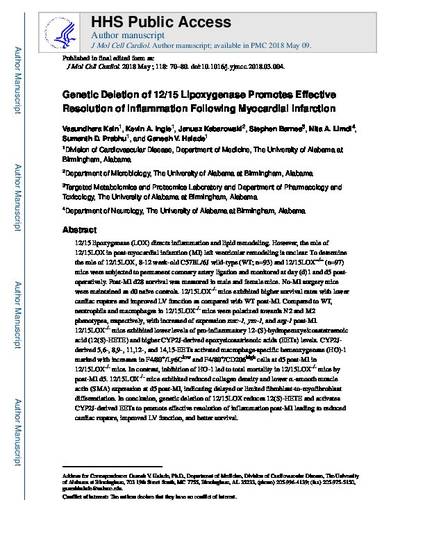
- Heart failure,
- Lipid mediators,
- Macrophages,
- Myocardial infarction,
- Neutrophils
12/15 lipoxygenase (LOX) directs inflammation and lipid remodeling. However, the role of 12/15LOX in post-myocardial infarction (MI) left ventricular remodeling is unclear. To determine the role of 12/15LOX, 8–12 week-old C57BL/6 J wild-type (WT; n = 93) and 12/15LOX −/− (n = 97) mice were subjected to permanent coronary artery ligation and monitored at day (d)1 and d5 post-operatively. Post-MI d28 survival was measured in male and female mice. No-MI surgery mice were maintained as d0 naïve controls. 12/15LOX −/− mice exhibited higher survival rates with lower cardiac rupture and improved LV function as compared with WT post-MI. Compared to WT, neutrophils and macrophages in 12/15LOX −/− mice were polarized towards N2 and M2 phenotypes, respectively, with increased of expression mrc-1, ym-1, and arg-1 post-MI. 12/15LOX −/− mice exhibited lower levels of pro-inflammatory 12-(S)-hydroperoxyeicosatetraenoic acid (12(S)-HETE) and higher CYP2J-derived epoxyeicosatrienoic acids (EETs) levels. CYP2J-derived 5,6-, 8,9-, 11,12-, and 14,15-EETs activated macrophage-specific hemeoxygenase (HO)-1 marked with increases in F4/80 + /Ly6C low and F4/80 + /CD206 high cells at d5 post-MI in 12/15LOX −/− mice. In contrast, inhibition of HO-1 led to total mortality in 12/15LOX −/− mice by post-MI d5. 12/15LOX −/− mice exhibited reduced collagen density and lower α-smooth muscle actin (SMA) expression at d5 post-MI, indicating delayed or limited fibroblast-to-myofibroblast differentiation. In conclusion, genetic deletion of 12/15LOX reduces 12(S)-HETE and activates CYP2J-derived EETs to promote effective resolution of inflammation post-MI leading to reduced cardiac rupture, improved LV function, and better survival.
Journal of Molecular and Cellular Cardiology, v. 118, p. 70-80
This article is the post-print author version. Final version available at: https://doi.org/10.1016/j.yjmcc.2018.03.004
Available at: http://works.bepress.com/ganesh-halade/42/